THIS POST INCLUDES:
1. Developmental Stages in Therapy
2. Early Childhood
3. Adolescents
4. Adults
5. Older Adults
6. Practical Applications
7. Free Download Assessing Clients Readiness and Preferences
DEVELOPMENTAL STAGES IN THERAPY
Art therapy is a tool that adapts to the unique needs of clients at various points in their lives. Whether working with young children discovering the world, teenagers grappling with identity, adults managing stress and transitions, or seniors processing life’s later chapters, art therapy offers a creative and compassionate pathway for healing and growth. In this blog post, we explore strategies for integrating art therapy into practice across developmental stages, share relatable real-world examples, and offer actionable insights for art therapists managing their own private practices.
Each stage of life brings its own set of emotional, cognitive, and social challenges. Research consistently shows that therapy outcomes improve when interventions are tailored to the client’s developmental needs. For art therapists, this means recognizing that creative expression is not a one-size-fits-all approach. Instead, the techniques and materials used should align with the client’s age, maturity, and life experiences.
For example, younger clients often communicate best through tangible, sensory experiences, while adolescents may benefit from methods that allow them to explore and assert their emerging identities. Adults might use art to process complex emotions tied to work stress or relational changes, and older adults can find solace and renewed purpose through creative reminiscence. By considering these developmental nuances, art therapists can design sessions that are both effective and deeply empathetic.
EARLY CHILDHOOD
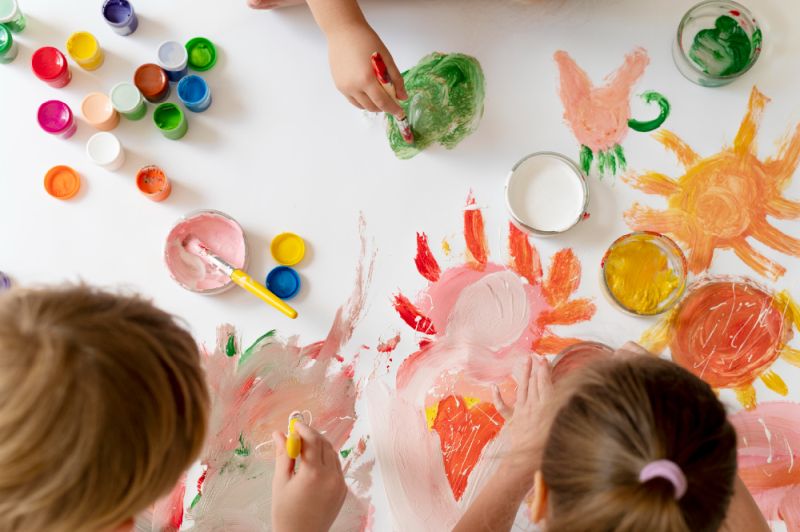
Young children are in a stage of rapid cognitive, emotional, and social development, where verbal communication skills are still emerging. During this period, art therapy offers a unique and invaluable outlet for non-verbal expression, allowing young clients to communicate feelings and experiences that they may not yet have the words for. Research in early childhood development consistently underscores the importance of play and sensory experiences in helping children make sense of the world around them. Art activities, therefore, serve as a natural extension of these developmental processes.
From a developmental perspective, young children learn primarily through sensory exploration and play. When children engage in activities like finger painting, playdough modeling, or collaging with tactile materials, they are not only exploring different textures and colours but also beginning to understand how to express and manage their emotions. These creative processes are essential because they provide a safe, structured environment in which children can experiment with representing their inner worlds. For example, the act of mixing colours in a painting might mirror a child’s attempt to blend conflicting feelings, offering a visual representation of emotional complexity that they cannot articulate verbally.
Moreover, these non-verbal expressions are critical in building the early foundations of self-regulation and emotional intelligence. Through art, children learn to observe and reflect on their emotions in a non-threatening way. They can externalize feelings of frustration, sadness, or joy without the pressure of finding the “right” words. In a therapeutic setting, this not only helps the child express themselves but also provides the therapist with important insights into the child’s internal experiences. For instance, a child who frequently uses dark hues might be communicating feelings of sadness or fear, while the spontaneous use of bright colours could indicate moments of happiness or relief. This visual language becomes a bridge for therapists to better understand and support the emotional needs of young clients.
Art therapy with young children also encourages the development of fine motor skills and cognitive abilities. The physical act of manipulating materials—whether it’s squeezing playdough or cutting out images for a collage—enhances hand-eye coordination and can promote early problem-solving skills. These activities not only foster creativity but also support developmental milestones that are crucial during early childhood. As children experiment with different materials, they also learn cause-and-effect relationships, spatial awareness, and the basics of planning and executing a task, all of which contribute to their overall growth.
Another important aspect of engaging young children in art therapy is the creation of a consistent and predictable therapeutic environment. Because young children thrive on routine and structure, incorporating regular art-making sessions can provide a sense of stability during times of emotional turmoil or life transitions. For children experiencing stress or change—such as starting school or dealing with family disruptions—the familiarity of a creative space can be both comforting and empowering. It offers them a dedicated time and place where they can express themselves freely, which in turn helps build trust between the child and the therapist.
A child who has recently experienced the separation of parents may struggle to articulate feelings of confusion and loss. In an art therapy session, the child might be invited to create a collage using images and colours that represent both the safe and challenging aspects of their world. Through this process, the child might choose imagery that symbolizes home and security on one side, while expressing feelings of isolation or disconnection on the other. The resulting artwork serves as both a mirror of the child’s internal state and a starting point for therapeutic dialogue, providing a non-verbal means to explore and ultimately understand their emotional experiences.
In addition to these benefits, art therapy in early childhood is also grounded in the principle of empowerment. When children are given the freedom to choose their materials and the themes they wish to explore, they are not only expressing themselves—they are actively participating in their own healing process. This sense of agency is particularly important during early developmental stages, as it helps to cultivate self-esteem and resilience. As children see their ideas and emotions take shape in a tangible form, they gain confidence in their ability to affect their own experiences, an insight that can be profoundly empowering as they grow and face future challenges.
Furthermore, integrating art therapy into early childhood interventions aligns with a broader movement in mental health care that emphasizes the importance of developmental sensitivity. By tailoring therapeutic techniques to meet the unique needs of young clients, therapists can create interventions that are not only more effective but also more respectful of the child’s developmental stage. This approach acknowledges that young children are not simply “miniature adults” but individuals with distinct ways of understanding and interacting with the world.
Engaging the youngest clients through art therapy harnesses the natural proclivity of children for sensory play and creative expression. It provides them with the tools to communicate complex emotions non-verbally, supports critical developmental milestones, and fosters a sense of safety and empowerment. As art therapists, embracing these methods allows us to meet young clients where they are—both developmentally and emotionally—creating a foundation for healthy emotional growth and resilience that can benefit them throughout their lives.
Real-World Example:
Consider a preschool client who has experienced a disruptive change, such as moving to a new home. Through a session focused on drawing their “happy place,” the child uses bright colors and familiar shapes to create a scene that represents comfort and security. This process not only provides the therapist with valuable insights into the child’s emotional state but also helps the child begin to cope with their feelings of loss and uncertainty.
Actionable Insight for Art Therapists:
- Use a variety of sensory materials that engage young clients.
- Create a predictable routine for art sessions to help build safety and trust.
- Encourage free expression without worrying about “correct” outcomes.
ADOLESCENTS
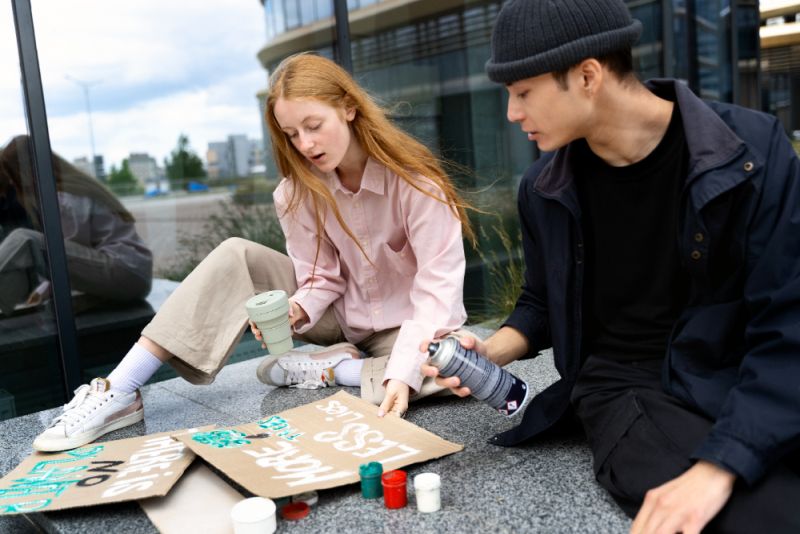
Adolescence is widely recognized as a period characterized by profound shifts in identity and emotional regulation. During this stage, teenagers are not only trying to define who they are but are also experimenting with different facets of their personality in response to evolving internal and external influences. This phase of development is marked by increased self-consciousness, a heightened sensitivity to social evaluation, and the onset of abstract thinking, which can sometimes intensify feelings of confusion and conflict.
During adolescence, the quest for identity is intertwined with the development of emotional complexity. Teenagers often experience rapid mood fluctuations and may struggle with reconciling conflicting feelings about themselves and their place in the world. The process of self-discovery can bring about intense internal conflicts as they weigh familial expectations, peer influences, and cultural norms. As Erikson’s theory of psychosocial development suggests, adolescence is a critical time for the emergence of identity versus role confusion—a period where the successful integration of various aspects of the self is vital for forming a coherent sense of identity.
Art therapy offers a unique, non-judgmental space where adolescents can safely explore these multifaceted experiences. By engaging in creative expression, young clients can externalize and visually articulate emotions that might otherwise feel overwhelming or too abstract to discuss. Through activities such as self-portrait drawing or collage-making, teenagers can experiment with different representations of themselves, allowing them to explore multiple identities and resolve internal conflicts. This process not only encourages self-reflection but also provides a tangible way for them to observe their own growth and change over time.
Furthermore, art therapy helps bridge the gap between thought and emotion. Adolescents might find it challenging to express their internal experiences verbally, especially when those experiences are complex or contradictory. The creative process enables them to bypass the limitations of language, using imagery, symbolism, and colour to capture the nuances of their emotional landscape. This mode of expression often reveals underlying themes and patterns that might not emerge through traditional conversation, offering both the client and the therapist deeper insights into the adolescent’s inner world.
Art therapy serves as a critical tool for navigating the intricate interplay of identity and emotional complexity during adolescence. It supports teenagers in not only understanding their own internal experiences but also in developing healthier coping mechanisms and a more integrated sense of self as they move toward adulthood.
Real-World Example:
A 15-year-old client struggling with self-image and peer pressure might engage in a collage-making session. By selecting images and words from magazines that resonate with their inner experiences, the adolescent creates a visual narrative of who they are and who they aspire to be. This exercise not only clarifies their self-concept but also empowers them to articulate their challenges in a non-judgmental environment.
Actionable Insight for Art Therapists:
- Incorporate reflective journaling alongside art-making to deepen insight.
- Utilize group sessions to allow adolescents to see shared experiences.
- Offer choices in materials and themes to reinforce autonomy and creativity.
ADULTS
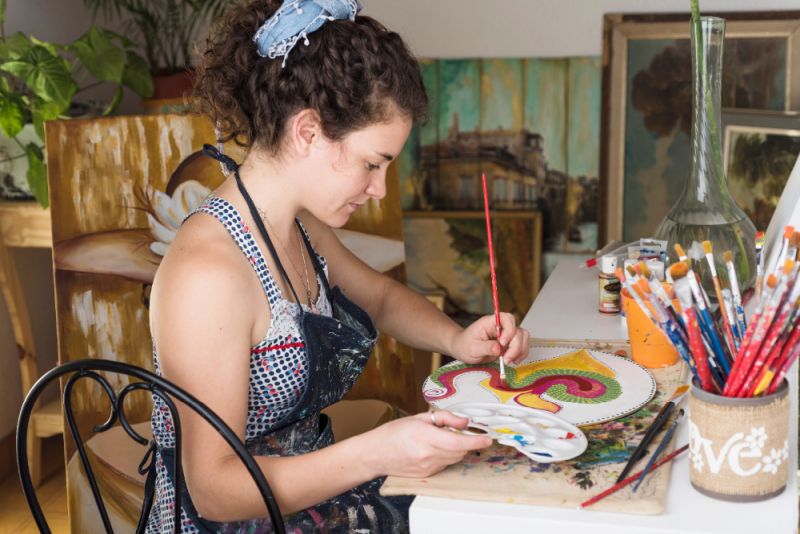
Adulthood is a period characterized by ongoing change and the need for adaptation. Major life transitions—whether they stem from career changes, relationship shifts, or the process of trauma recovery—often challenge even the most well-established coping mechanisms. Over time, the strategies that once provided comfort may become less effective or even counterproductive in the face of new challenges. For instance, a career change might bring about a loss of identity or financial uncertainty, while a divorce can upend long-standing social and emotional support systems. Similarly, recovery from trauma often requires individuals to confront and reframe deeply ingrained patterns of behaviour and thought.
Art therapy offers a distinctive and creative avenue to explore these complex emotions and life changes. Unlike traditional talk therapies that rely heavily on verbal expression, art therapy harnesses the visual and symbolic language of art. This modality enables adults to express feelings and experiences that might be difficult to articulate with words. Through the process of creating art, clients can externalize internal conflicts and reframe their perspectives in tangible, often transformative ways.
Consider a client experiencing the turmoil of a mid-life career shift. While they might have relied on familiar routines and professional identities for years, the abrupt change can evoke a profound sense of loss and uncertainty. In an art therapy session, the client might be encouraged to create a visual representation of their past professional self alongside a depiction of their emerging identity. Such an exercise not only validates the emotions of loss and disorientation but also facilitates a constructive dialogue about future possibilities and personal growth.
Similarly, in the context of relationship transitions—such as the end of a long-term partnership—art therapy provides a non-verbal means of processing grief, anger, or liberation. Clients might use mediums like collage or mixed media to juxtapose images and symbols that represent both the pain of separation and the potential for renewal. This duality in expression helps reveal the complexity of emotions involved and fosters a more integrated sense of self.
When addressing trauma recovery, art therapy can be particularly effective in helping clients navigate the labyrinth of memories and emotions that accompany such experiences. Trauma often leaves individuals with a fragmented sense of self, where old coping mechanisms may hinder rather than help. Creative processes, such as mask-making or symbolic self-portraiture, enable clients to explore different facets of their identity in a safe space. By reimagining their experiences through art, they can gradually transform feelings of vulnerability into sources of empowerment.
Art therapy sessions can incorporate mindfulness techniques, such as focusing on the sensory experience of materials or the rhythm of brushstrokes, which helps ground clients in the present moment. This mindful engagement with the creative process can reduce anxiety and promote emotional regulation, making it easier for adults to face and process their complex feelings.
The dynamic nature of adulthood necessitates flexible and innovative coping strategies. Art therapy provides a robust framework for adults to reexamine and rebuild their emotional landscapes during significant life transitions. By facilitating the externalization of internal struggles and enabling a reflective dialogue through creative expression, art therapy not only helps clients process their complex emotions but also supports them in developing new, adaptive perspectives on their evolving lives.
Real-World Example:
Imagine an adult client facing the aftermath of a difficult divorce. Through a guided art therapy session that involves creating a “transformation mask,” the client can visually represent both the pain of the past and the hope for the future. By contrasting harsh, dark tones with lighter, more vibrant hues, the artwork becomes a metaphor for emerging from loss with renewed strength.
Actionable Insight for Art Therapists:
- Design sessions that focus on both reflection and future planning.
- Use symbolic exercises (e.g., mask-making, timeline drawing) to represent dual aspects of change.
- Integrate mindfulness techniques to help clients remain present while exploring difficult memories.
OLDER ADULTS
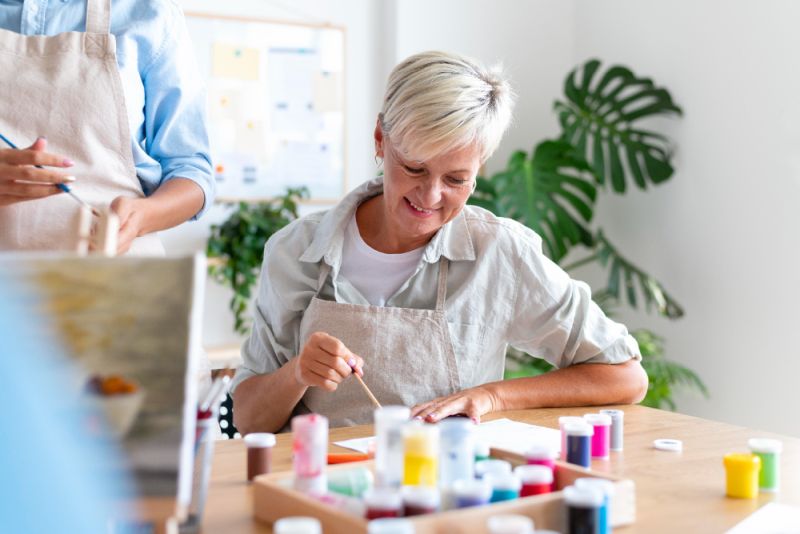
In older adulthood, clients often confront a unique set of challenges that include memory loss, bereavement, and the need to redefine identity in the context of life’s later chapters. As people age, the process of reminiscence naturally becomes more significant. Art therapy offers a supportive environment where seniors can revisit meaningful moments from their past, helping to restore a sense of continuity and purpose. By engaging in creative expression, older adults have the opportunity to not only honor their history but also to integrate these experiences into a renewed understanding of self.
Research in gerontology highlights the therapeutic benefits of reminiscing. When older adults create art that reflects their personal history—whether through collage, painting, or other mixed-media projects—they often report an enhanced sense of self-worth and reduced feelings of isolation. For example, a client might create a visual timeline that captures pivotal moments in their life, from childhood memories to significant milestones, which not only validates their experiences but also serves as a narrative that connects their past with their present identity. This process of visual storytelling fosters emotional resilience and can be instrumental in mitigating feelings of loss or disconnection that may accompany aging.
The act of reconnecting with one’s past through art can provide a structured opportunity for reflection. Art therapy sessions tailored to older adults often encourage the exploration of themes such as legacy, life achievements, and even unresolved emotions related to grief or regret. These sessions enable clients to express complex feelings that are sometimes too challenging to articulate verbally. For instance, a session might involve creating a “memory quilt” where participants piece together fabrics or images that symbolize various chapters of their lives. This tactile and creative process not only facilitates reminiscence but also empowers clients by reinforcing their enduring identity despite the inevitable changes that come with aging.
In addition to reminiscence, art therapy for older adults can serve as a bridge to reconnection—not just with their past, but also with their present community and social networks. Collaborative art projects, such as group murals or intergenerational art workshops, can help reduce the sense of isolation that many seniors experience. By sharing their artwork and the stories behind it, older clients can forge new connections, reestablish social bonds, and find renewed meaning in community engagement. These shared experiences are pivotal for fostering an inclusive environment where older adults feel both valued and understood.
Ultimately, embracing reflection and reconnection through art therapy can lead to significant improvements in mental health and quality of life for older clients. The creative process not only allows them to navigate the inevitable challenges of memory and loss but also provides a pathway to rediscovering purpose and joy in later life. Art therapists working with this population are uniquely positioned to facilitate these meaningful experiences, guiding clients toward a more integrated, resilient sense of self that honors both their past and their ongoing evolution.
Real-World Example:
A senior client coping with feelings of isolation and the loss of a long-term partner might engage in a “memory quilt” project. In this exercise, the client assembles pieces of fabric, photographs, and mementos to create a quilt that symbolizes their life story. The tangible act of piecing together fragments of memory not only evokes a sense of nostalgia but also affirms the client’s enduring identity and resilience.
Actionable Insight for Art Therapists:
- Encourage the use of mixed media to capture the complexity of life experiences.
- Provide opportunities for collaborative art projects that connect older adults with community resources.
- Use art as a medium for storytelling, inviting clients to share personal narratives that celebrate their history.
PRACTICAL APPLICATIONS
Assessing Client Readiness and Preferences
Before initiating art therapy, it is essential for therapists to assess a client’s developmental stage and determine their readiness for creative exploration. This process ensures that interventions are appropriately matched to the client’s cognitive, emotional, and social capacities, thereby fostering an environment where meaningful therapeutic work can occur.
Methods of Assessment
Art therapists typically employ a combination of formal and informal assessment tools to determine a client’s readiness for art therapy. These methods can include:
- Clinical Interviews: Engaging in open-ended conversations helps therapists understand the client’s developmental history, emotional regulation skills, and previous experiences with creative activities.
- Observation: Noting how clients interact with art materials during initial sessions can provide valuable insights into their comfort level, motor skills, and capacity for abstract thought.
- Standardized Assessments: In some cases, validated questionnaires or developmental checklists can be useful, particularly with younger clients or when working within educational or clinical settings.
- Family or Caregiver Input: For children and adolescents, input from parents or teachers can shed light on a client’s developmental stage and readiness for a creative therapeutic approach.
Practical Considerations
When assessing developmental readiness, art therapists should also be attuned to the client’s cultural background and individual learning styles. Some clients might demonstrate advanced creative skills or emotional maturity relative to their chronological age, while others might need more foundational interventions. Flexibility is key: adjusting the complexity of art activities to match a client’s current capabilities can help avoid frustration and encourage engagement.
A young child who struggles with fine motor skills may benefit from using large, easy-to-handle materials like finger paints or chunky crayons. Conversely, an adolescent ready to explore abstract concepts might engage in digital art or collage-making, allowing them to experiment with symbolism and self-expression. Such tailored interventions ensure that the creative process remains accessible, empowering, and therapeutic.
Building Readiness Over Time
Readiness for art therapy is not a static quality—it can evolve with the therapeutic process. Some clients might initially exhibit hesitance or limited creative expression due to developmental or emotional factors. In these cases, art therapists can gradually build readiness through structured activities that promote self-efficacy and trust. Starting with guided exercises that require minimal decision-making can help clients become comfortable with the materials and the process. As their confidence grows, the activities can be expanded to encourage more independent exploration and deeper expression.
For instance, an adolescent who is initially unsure about engaging in art might start with a simple, therapist-led project. As the client begins to express thoughts and emotions visually, the therapist can gradually introduce more open-ended tasks that challenge the adolescent to reflect on personal identity and emotional experiences. This scaffolding approach not only builds readiness but also enhances the therapeutic alliance, as clients feel supported and understood throughout their developmental journey.
Actionable Insights for Therapists
- Conduct Comprehensive Assessments: Use a blend of clinical interviews, observations, standardized tools, and caregiver insights to determine developmental readiness.
- Tailor Interventions: Match art therapy techniques to the client’s developmental stage and skill level. For example, use tactile, simple activities for younger clients and more abstract, reflective projects for older ones.
- Be Flexible: Recognize that readiness is dynamic. Be prepared to adjust interventions based on the client’s evolving abilities and emotional state.
- Foster a Supportive Environment: Ensure that the creative space is welcoming and free of judgment, encouraging clients to experiment and express themselves at their own pace.
- Monitor Progress: Regularly review and document client responses to art therapy sessions to track developmental and emotional progress, and refine techniques as needed.
Assessing a client’s developmental stage for readiness in engaging in art therapy is a critical step that influences the overall effectiveness of the intervention. By understanding and tailoring approaches to developmental milestones, art therapists can create a therapeutic environment that honors the client’s unique abilities and challenges. This careful assessment not only maximizes the benefits of creative expression but also reinforces a compassionate, individualized approach to healing and growth. Embrace these strategies to ensure that each client, regardless of age or developmental stage, finds a supportive pathway to explore and express their inner world through art therapy.
Customizing Techniques and Materials
Tailoring the art therapy experience is essential. While some clients may thrive with open-ended creative tasks, others may benefit from more structured exercises that guide their focus. Consider the following strategies:
- For Children: Use vibrant, tactile materials that invite play and spontaneity.
- For Adolescents: Provide options that encourage experimentation with identity, such as digital art tools or collage.
- For Adults: Focus on symbolism and metaphor to articulate complex emotions, integrating elements of mindfulness and reflection.
- For Older Adults: Use familiar, nostalgic materials that facilitate memory recall and emotional connection.
Fostering a Collaborative Environment
Creating a safe and collaborative environment is at the heart of effective art therapy. Encourage clients to share their work and discuss the meanings behind their creations. This dialogue not only validates their experiences but also builds a therapeutic alliance that supports healing across all developmental stages.
Bringing It All Together
Art therapy is a versatile and evidence-based approach that adapts beautifully to the diverse needs of clients across different developmental stages. Whether you are working with a preschooler exploring basic emotions, a teenager grappling with identity, an adult navigating life transitions, or an older adult reconnecting with cherished memories, the principles of art therapy offer a compassionate and creative pathway for healing.
As an art therapist managing your private practice, take a moment to reflect on your current client base and consider how you can tailor your sessions to better address their developmental needs. Experiment with new techniques, gather feedback from your clients, and continuously educate yourself on the latest research in art therapy. By adapting your methods to the unique challenges faced at different life stages, you empower your clients to express themselves, heal, and thrive.
Start small—perhaps by introducing a new exercise tailored for adolescents or a reflective project for older adults—and observe the impact on your clients’ engagement and emotional growth. Your thoughtful approach can pave the way for more meaningful and lasting change in the lives of those you serve.
By acknowledging and addressing the distinct needs of clients at various developmental stages, you not only enhance the effectiveness of your therapeutic interventions but also build a practice that is both compassionate and resilient. Remember, the art you create in your sessions is a reflection of the vibrant, multifaceted human experience—and with every stroke, you help your clients discover the beauty in their own evolving stories.
FREE DOWNLOAD: Art Therapy Exercise
SIGN UP below to gain access to our RESOURCE LIBRARY and download the FREE Assessing Clients Readiness and Preferences.
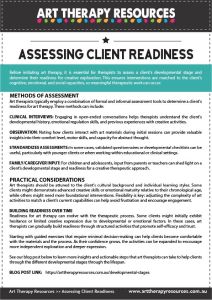
BUILD YOUR ART THERAPY REFERENCE MATERIALS:
Pin this image to your Pinterest board.
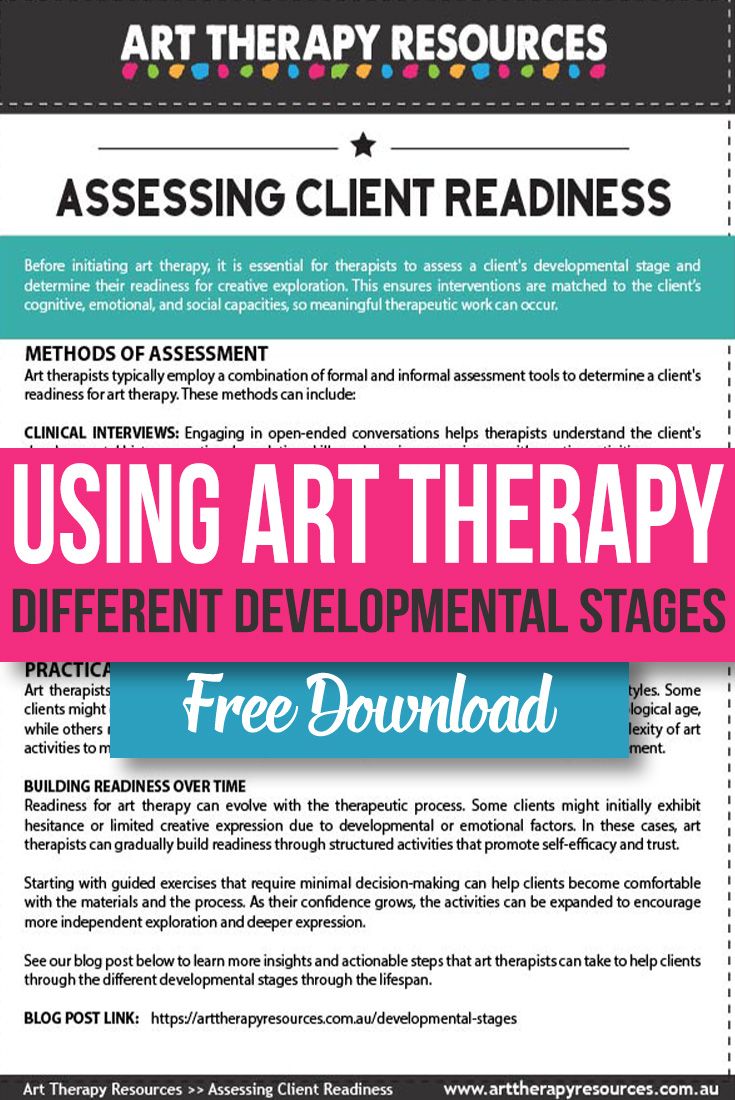
SHARE KNOWLEDGE & PASS IT ON:
If you’ve enjoyed this post, please share it on Facebook, Twitter, Pinterest. Thank you!
